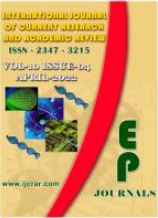Abstract Volume:10 Issue-4 Year-2022 Original Research Articles
 |
Online ISSN : 2347 - 3215 Issues : 12 per year Publisher : Excellent Publishers Email : editorijcret@gmail.com |
Soil borne diseases which are caused to various plants include a wide variety of soil microbes like fungi and bacteria, among which Fusarium wilt is one such disease caused by Fusarium oxysporum cubense in banana plants. Wilt disease or the panama disease of plant is among the most destructive disease of banana in the tropics and even the control methods like field sanitation, soil treatments and crop rotations have not been a long term control for this disease. An alternative method of treating Fusarium oxysporum was adopted by using various natural plant leaves of Gliricidia sepium and Piper nigrum. Nanoparticles are small particles with a dimension of 10-9 and 10-10. Green synthesis is a new method developed for the synthesis of nanoparticles which is small in size, large surface area and eco- friendly. Leaf extracts of these plants were used for synthesis of copper and zinc nanoparticles, as nanoparticles are powerful antimicrobial agents. The extract is prepared with a stock solution of 100mM copper sulphate and 100mM zinc sulphate. The leaf extracts were prepared with 5 solvents (Distilled water, Propane, Hexane, Acetone and Methanol).The action of plant leaves were observed by the zone of inhibition obtained with a concentration of 50, 100 and 150µl respectively. The result was more in copper nanoparticles of leaf extract as compared to the zinc nanoparticles of particular leaf extracts but the zinc particles with methanol and propane showed good result with particular leaves. In dried condition of leaves copper nanoparticles with propane as solvent exhibited a greater zone of inhibition. Moreover the solvent, methanol showed good results with both zinc and copper nanoparticles. The synthesized nanoparticle were characterized by UV-VIS spectrophotometry to confirm the formation of nanoparticles. Green synthesis is used namely because of low cost, simple, use of less toxic materials, most important is eco-friendly.
How to cite this article:
Prem Jose Vazhacharickal, Nissy Mary Joseph, Jiby John Mathew and Sajeshkumar, N. K. 2022. Green Synthesis of Copper and Zinc Nanoparticles from Gliricidia sepium and Piper nigrum and Evaluation of their Antifungal Activity against Fusarium oxysporum cubense: An Overview.Int.J.Curr.Res.Aca.Rev. 10(4): 1-29doi: https://doi.org/10.20546/ijcrar.2022.1004.001



Quick Navigation
- Print Article
- Full Text PDF
- How to Cite this Article
- on Google
- on Google Scholor
- Citation Alert By Google Scholar
